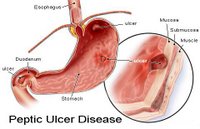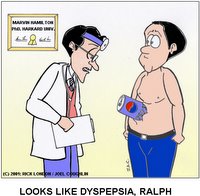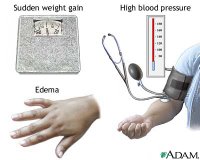| Some Stuff |
|
| Some MORE Stuff |
|
|
| Irritable Bowel Syndrome |

IBS is a functional disorder affecting mainly the small intestines. There is an increase sensitiveness of the nerves and muscles in the bowels so that eating cause them to contract excessively leading to changes in bowel function. Since the bowels are not working or behaving as they should normally be, the symptoms appear either during a meal or shortly after. The increased intestinal contractions forces the food towards the intestines more quickly which leads to the appearance of symptoms.These symptoms include abdominal pain (crampy), flatulence, bloating, and diarrhea. There can also be mucus in the stool. In some individuals the opposite happens so that the passage of food slows down causing constipation instead of diarrhea. The symptoms range from mild to severe depending on the sensitivity of the individual. The exact cause on why the intestines are behaving as such is still unknown. Research show that there are certain foods that trigger the condition. Stress and other illnesses in the gastrointestinal tract may also trigger IBS. The foods that tend to trigger IBS include milk products (cheese, ice cream, etc), fatty foods, alcohol, chocolates, caffeinated and carbonated drinks. These foods does not trigger IBS in all individuals who have the syndrome. If you have IBS it is best for you to observe what food really triggers the appearance of your symptoms so that you can lessen or avoid such foods. There is no specific cure for IBS. What we can do is relieve symptoms by going through certain changes:
- Changes in the Diet/Eating habits. It has been found that fiber helps control constipation and it also reduces symptoms of IBS. It is therefore important to incorporate high fiber foods in your everyday meals. Some fiber-rich foods include vegetables like raw broccoli, raw carrots, and cabbage. Fiber is also found in cereals, bread, and fruits (apple). Try also to eat lesser amount of food during meal times or if not try eating more frequently but in smaller amounts. Increasing your fluid intake also helps.
- Try to reduce stress by having a regular exercise. Exercise will give your body lots of benefits and it also helps lessen risk of cardiovascular disease. There is a great variety of exercises which you can choose from. Choose the one which you will really enjoy and which you will be able to continue regularly. You can also include some meditation techniques, yoga, or pilates.
- Medications are available to help relieve symptoms. These include anti-diarrheal meds, laxatives for constipation, antispasmodics, and antidepressants.
|
|
|
|
| Lactose Intolerance |

Lactose intolerance is a rather common condition in infants, young children, or adults. It is a genetic problem which has been there since you were born. The problem lies in the inability to digest lactose because of deficiency or absence of the enzyme lactase. This enzyme lactase is produced by the cells found in the small intestines. It is responsible for breaking down the major sugar found in milk which is called lactose into simpler forms which are glucose and galactose. Glucose and galactose once broken down are then absorbed into the bloodstream. The undigested lactose later ferments and it is then responsible for the signs and symptoms felt by people with lactose intolerance. These symptoms include nausea, abdominal pain, bloating, and diarrhrea. They are usually felt after intake of lactose containing foods or drinks. The severity vary depending on the amount of lactose a person can tolerate, his digestion rate, age, and ethnicity. Lactose is present in milk and in all foods that contain milk. These foods include ice cream, yogurt, butter, sherbet, cottage cheese, and in aged cheeses like cheddar and Swiss. Lactose can also be found in prepared foods like salad dressings, cereals, breads, cakes, cookies, biscuits, pancakes, etc. Since some people can tolerate small amounts of lactose, these foods can still be enjoyed by them in small amounts. Since calcium is also present in most foods containing lactose, the big concern is in those lactose intolerant individuals who need calcium in their diet. There are calcium-rich foods with no lactose content for this types of individuals. These foods include fish, tofu, broccoli, canned tuna, lettuce, salmon, and sardines. If there’s really a need to eat lactose containing foods, you can use a lactase tablet or lactase liquid available commercially to help in the digestion of lactose. Lactose intolerance is not a big problem. Even lactose-free infant formulas are available for the babies to be able to enjoy their milk inspite of their digestive problems. |
|
|
|
| Avian Influenza (Bird Flu) |

Bird flu is an infectious disease caused by avian influenza viruses. It is seen in chickens, ducks, and other types of birds. These viruses are very contagious among animals and on rare occasions they have crossed the species barrier to infect humans.
Among these influenza viruses it is the H5 and H7 subtypes which cause highly pathogenic disease. It is the H5N1 virus which has caused the largest and most severe outbreak on record causing the death of so many birds.
The big question is that, is there a risk for human health? Yes, there is. First, there is a risk of direct infection when the virus passes from poultry to humans. Another risk is that this virus (H5N1) has the capability of changing into a very infectious form which can infect humans and then transfer easily from person to person. It this happens, this could lead to a major flu outbreak or a pandemic.
In order to start an influenza pandemic, there are three conditions that have to be met: emergence of a new virus subtype, this virus is able to infect and cause disease in humans, and this virus can spread easily and efficiently among humans. The third condition has not been fulfilled yet. As long as the H5N1 virus continues to infect birds, there is still the risk that this virus will meet the third condition.
How do we get infected? The main mode of transmission is by close contact with live infected birds and to objects contaminated by their feces. These infected birds excrete large quantities of the virus in their feces so that there is high exposure in poultry workers, people living in poultry farms, and people selling live poultry. People who work in slaughter houses and those who prepare poultry for cooking are also at high risk of contracting the disease. Cockfighting can be another way of spreading the disease. The mere flapping of the bird’s wings increases incidence of transmission.
The signs and symptoms of bird flu resemble those of conventional influenza. There are about 2 to 8 days (average 3 days) from exposure to the appearance of symptoms. The symptoms include fever, cough, muscle pain, and sore throat. Individuals with more virulent type of virus may develop acute respiratory distress or viral pneumonia which are more life-threatening.
Bird flu vaccine are not yet available commercially. This vaccine still needs to be tested and licensed. There are antiviral flu drugs which can be used in case of human transmission. Since the virus is easily killed by thorough cooking and since avian flu is not transmissible through food, it is safe to eat chicken. |
|
|
|
| Food Poisoning |

Food poisoning occurs as a result of eating food contaminated with germs. This is often due to improper handling of food from the time it was prepared to the time it is stored until it is eaten. This problem is often encountered in parties, picnics, or any social gathering where it involves a large group of people. What happens is that during social gatherings the food are usually prepared in bulk and they are left in unrefrigerated for too long allowing the germs to multiply in the food. Improper handling of food during the preparation also contributes to the incidence of food poisoning. Sometimes kitchen utensils are used interchangeably between raw and cooked foods increasing further bacterial food contamination. Food poisoning usually is noted within 2 hours or more after eating the contaminated food. The symptoms are nausea and vomiting, diarrhea, abdominal pain, fever, headache, and weakness. Although diarrhea and vomiting can be present in conditions not associated with food poisoning, adequate medical history can always lead to the correct diagnosis. The treatment involves increase fluid intake to replace whatever is lost through vomiting and diarrhea. If the person is unable to drink because of the vomiting, an IV fluid can be inserted. Avoiding dehydration is the main goal of treatment. Inability to treat can lead to serious problems and may also lead to death. Here are some very important measures that needs to be followed to prevent food poisoning. These are especially important for pregnant mothers, babies, elderlies, and those who have serious medical problems and those with weak immune system:
1. Always wash hands when handling food. 2. Separate food containers for raw and cooked food. 3. Refrigerate food that will not be eaten at once. 4. Always look for the date of expiration before eating packaged food. 5. Eat only freshly cooked food. |
|
|
|
| GI Ulcer |

Many people don’t understand what ulcers really are. Sometimes when they have abdominal pain, they refer to it as ulcer just because the pain is located in the abdominal area. But what really is an ulcer? Ulcer is an open wound on the lining of the digestive tract. It can be seen on the esophagus, stomach, duodenum, or anywhere along the intestinal tract. Ulcers are painful. The pain is described as a burning pain located in the middle upper abdominal area which can last for several minutes to several hours. Some individuals experience the pain soon after intake of meals or several hours after. It can also occur at night disturbing a person from his sleep. Sometimes the pain is accompanied by bloating, vomiting, and loss of appetite which can lead to unexpected weight loss. Increased acid production in the digestive system is thought to be the primary cause of ulcer. Some attribute it to the presence of a bacteria called Helicobacter pylori. Use of anti-inflammatory medications like for example aspirin and ibuprofen also play a role. Their long-term use may cause damage to the lining of the stomach. Genetic predisposition and physical, emotional, and psychological stress aggravate the condition. Use of medications which neutralize the acid and medications which decrease acid production are the primary line of therapy. These medications are given for several weeks. For the H. pylori, this is treated with a triple drug therapy using two antibiotics and a medication which acts to decrease acid production. Lifestyle modification also play a very important role in the improvement of the condition. Avoidance of smoking, alcoholic beverages, caffeine, chocolates, and spicy foods are some of these. Treatment of this condition as soon as diagnosed is very important. The condition can lead to perforation of the ulcer which can further cause problems like bleeding and obstruction if left untreated. Presence of blood in the stools and pain radiating to the back are some of the signs that will make you suspect that your ulcer is progressing. |
|
|
|
| Dyspepsia |

Dyspepsia affects people at any age. It is characterized by the presence of pain in the epigastric area (upper middle part of the stomach). The pain is described as burning, with feeling of fullness in the stomach. Sometimes there is heart burn, nausea and vomiting, and loss of appetite. The stomach normally secretes an acid which aids in the digestion of foods. The esophagus, stomach, and intestines are protected from the adverse effects of the acid because of the presence of a mucus barrier lining the mucosa of the intestinal tract. Sometimes this barrier is damaged leading to irritation of the inner lining of the intestinal tract by the acid. This now leads to ulcer formation and this is one cause of dyspepsia. Another cause can be acid reflux disease. Here, some of the stomach contents which are already mixed with acid propel back up into the esophagus because the valve which should prevent this from happening is not working properly. This causes irritation and the condition is made worse with smoking, heavy alcohol drinking, and eating heavy meals. Anti-inflammatory drugs also play a role in the causation of dyspepsia. This drugs include ibuprofen, aspirin, ketoprofen, and naproxen. Other contributory factors include pregnancy, stress, and anxiety. Presence of other conditions like hiatal hernia wherein there is a defect in the diaphragm, and also Helicobacter pylori which is a bacteria normally present in the mucus layer of the stomach, may contribute to the occurrence of the condition. There are a couple of drugs available to treat the condition like antacids which neutralize the acidity of the stomach, proton pump inhibitors or H2 antagonists which decrease the amount the acid produced. For H. pylori treatment includes use of two types of antibiotic and a proton pump inhibitor. If any of these medicines does not work then endoscopy which uses a small instrument with camera introduced into the mouth to view the insides of the intestinal tract may be used. Avoidance of certain foods, lessening stress, smoking cessation, and eating at least 2 hours before bedtime are some of the lifestyle modifications we can do to avoid dyspepsia. This is a controllable and treatable condition. A lot of self control and behaviour modification improve the condition. |
|
|
|
| Eclampsia |

Eclampsia is preeclampsia plus seizures. It may develop if preeclampsia is not controlled or it may develop even without prior development of preeclampsia. It is a life-threatening emergency condition affecting all women of all ages usually occurring prior to delivery. The risk usually increases in multiple gestations, molar pregnancy, nulliparous women age 35 and above, strong family history, and those with secondary conditions like hypertension and kidney disease. It can cause permanent damage to the vital organs and can even lead to coma or death if left untreated.
The exact cause of eclampsia is still unknown. Some researchers relate it to the placenta and fetal membranes because of improvement of the condition following delivery. Just like preeclampsia, there is also severe headache, epigastric or right upper quadrant pain, and problems in vision. The only difference is the presence of seizures in eclampsia. The patient may have only one or more than one episode of seizure which may last for 1 minute or more. This may be accompanied by protrusion of the eyes, foaming of the mouth, and stopping of breathing during the episode. This accounts for the damage to the vital organs and to the central nervous system. This can also cause the death of the baby or if not can lead to prematurity, intrauterine growth retardation, decreased oxygen delivered to the baby, or premature separation of the placenta from the inner linings of the uterus.
Magnesium sulfate is the drug given to the mother to prevent further occurrence of seizures. Delivery of the baby is the treatment of choice especially if the baby is already 28 weeks of gestation. Below this, management should be weighed between the viability of the fetus and the resulting complications to the mother and child. |
|
|
|
| Preeclampsia |

Pre eclampsia is a very common condition seen during pregnancy. It is a condition that should be closely monitored and immediately treated because it is associated with a high degree of mortality not only to the mother but also to the baby. It can develop gradually during the course of the pregnancy or it may arrive suddenly anytime. It is commonly seen during the second half of pregnancy although it can occur during delivery or even during the first few days after the baby is born. The exact cause of pre eclampsia is still unknown. One possible cause is that the placenta does not get enough blood supply because the blood vessels particularly the arteries are the ones which are primarily affected. The placenta is the one which gives enough nutrition and oxygen to the baby. With insufficient blood flow the result is small or low birth weight baby. Other possible causes include poor nutrition, injury to the blood vessels, or lack of certain ions such as calcium and magnesium. Another danger with this condition is that it increases the risk of premature separation of the placenta from the inner lining of the uterus which may cause severe bleeding and can lead to shock. Signs and symptoms of pre eclampsia are: high blood pressure, presence of excess protein in the urine usually after the 20th week of pregnancy, changes of vision, severe headaches, nausea and vomiting which can be excessive, no urine or decreased urine output, pain in the right upper abdomen, and sudden weight increase in weight. The best treatment of this condition is delivery of the baby especially if the baby can live outside the mother’s womb which is usually after the 36th week of pregnancy. Labor can be induced or if not possible a cesarean section is performed. If is still too early to deliver the baby then other measures should be done while waiting for the right time to deliver. Bed rest is usually advised because it can lower the blood pressure and increase blood flow to the placenta. Blood pressure monitoring is regularly done together with biophysical profiles to determine condition of mother and baby. If the condition is severe, bed rest can be done in the hospital for better monitoring and immediate action can be done for any adverse events. Some medications can also be given to the mother to lower the blood pressure. Magnesium sulfate is also given IV during the delivery to prevent seizures and to increase blood flow to the uterus. Pre eclampsia is usually common in first pregnancy. The risk of having the condition increases in multiple pregnancy, obese mothers, too young and too old mothers, positive family history, and those who are suffering from other conditions like diabetes, chronic hypertension, rheumatoid arthritis, or a kidney problem. Whenever you feel any of the symptoms mentioned while you are pregnant, do not hesitate to visit your doctor. |
|
|
|
| Hyperemesis Gravidarum |

This condition means uncontrollable, severe, persistent nausea and vomiting seen during pregnancy. It is also known as morning sickness. It is commonly seen during the 1st trimester of pregnancy particularly during the 8th to 12th week. The symptoms usually resolve by the 16th week or in the 2nd trimester. There is increased prevalence in multiple and molar pregnancies.
The precise cause of this condition is still unknown but studies show that the rapidly rising levels of the hormone human chorionic gonadotropin secreted by the fetus and also the increasing estrogen levels in the mother play a role. The nausea and vomiting experienced by the mother is more worse when the pregnancy is multiple or there are more than one baby inside the mother’s womb. In rare conditions, such as the presence of hydatidiform mole, nausea and vomiting becomes unbearable.
Nausea and vomiting is a normal occurrence during pregnancy and researchers believe that this is a protective mechanism. Many of these foods that mothers react to may contain certain substances that may cause harm to the fetus during the first trimester. It is also observed that the risk of miscarriage is higher in women without the symptoms. Although the condition is protective, it is also harmful to both mother and child. It can cause dehydration when severe, and may result to weight loss, nutritional deficiency, abnormal electrolyte levels, and acid-base imbalance. Administration of IV fluid is done for the severe cases. Decreased skin turgor is a sign of dehydration |
|
|
|
|
|